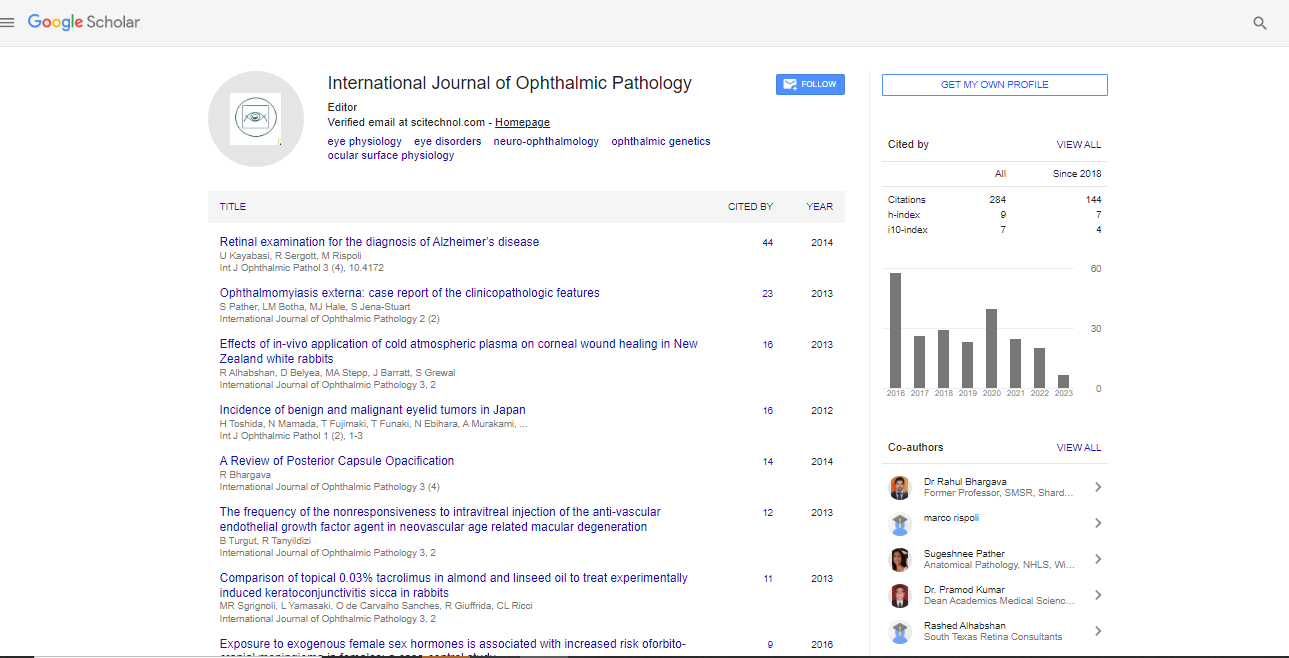Three techniques to adjust IOP immediately following Femtosecond Laser-Assisted (FLACS) & Micro Incision Cataract Surgery (MICS) to avoid IOP spikes (The post-operative complication in cataract surgery)
John S Jarstad
University of Missouri School of Medicine USA
: Int J Ophthalmic Pathol
Abstract
To determine the accuracy of current techniques to estimate the intraocular pressure immediately following FLACS and MICS surgery on the operating theatre table, 176 consecutive uncomplicated FLACS and MICS patients had their IOP estimated with palpation by an experienced cataract / glaucoma surgeon (25,000+ cases) and experienced senior ophthalmology residents in their final year of training. Intraocular pressure (IOP) was then verified with a Barraquer (15 to 21mmHg) sterile surgical hand-held tonometer (Ocular Inc. $340 USD) and a Tono-Pen Avia (Rreichert Co $4000 USD). IOP was checked before and adjusted immediately after cataract surgery & IOP measured again day one post op. A control group did not have IOP adjusted if IOP as <30mmHG or over 10mmHg at immediate case completion. We found that immediate post-operative IOP thought to be safe by palpation ranged from 9mmHg to 67mmHg when verified by tonometry at case completion in the operating theatre. There was less than 5mmHg average IOP difference from measurements immediately post-op to day one post-op in clinic. As many as 33% of post-op cataract patients required IOP adjustment in clinic at their one day post op visit if IOP was not adjusted immediately post-op. Findings: An unexpected finding was that eyes that had immediate post op IOP adjustment in theatre were up to 4X less likely to develop cystoid macular edema (CME). There was an additional unexpected financial benefit to adjusting IOP immediately at case completion with a savings of $44,000USD per ophthalmologist per year calculated by an industrial engineer in lost opportunity cost savings by not having to treat elevated IOP in clinic the next day. Conclusion & Significance: Immediate IOP adjustment in the operating theatre at case completion has both medical and financial implications in treating and avoiding post-operative pressure spike, the number one post-operative complication in FLACS and MICS surgery.
Biography
John S Jarstad is an Associate Professor and Director of Cataract & Refractive Surgery at University of Missouri. He is a graduate of Brigham Young University (B.S.), University of Washington Medical School (Seattle WA) and completed an Internship and Residency at the Mayo Clinic in Rochester MN in ophthalmology. He was a medical student research fellow at the N.I.H. Bethesda MD. Dr. Jarstad is past president of the Washington State Academy of Eye Physicians and Surgeons, a member of the American Society of Cataract and Lasik surgeons, and was elected to the Royal Society of Medicine - United Kingdom in 2006. Dr. Jarstad is the author of one book and more than 90 publications and presentations in the eye surgery literature. He is the inventor of the Jarstad Refractive Cataract Surgery Marker, the first injectable foldable lens inserter (Chiron Passport) and an FDA phase I, II and III clinical investigator for medications and phaco machines used in eye surgery. Along with family members, he has participated in 41 short term medical missions to Egypt, Zimbabwe, Angola, Madagascar and Nigeria Africa, the Philippines, Vietnam, Cambodia, Indonesia and North Korea.
E-mail: jarstadj@health.missouri.edu
 Spanish
Spanish  Chinese
Chinese  Russian
Russian  German
German  French
French  Japanese
Japanese  Portuguese
Portuguese  Hindi
Hindi 